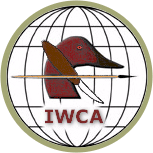Don Baiar: Artist Teacher
Text and photos by Bill Einsig unless noted
Don Baiar is an organizer of the Columbia Flyway Wildfowl Show in Vancouver, Washington, and an active carver. But, it's his neatly organized teaching studio that occupies most of his time.

|
Chatting with an artist at an exhibition is typically a pleasant, but superficial, experience. Meeting them in their own studio, on the other hand, is a totally different experience. Maybe it's because the studio, the workshop, becomes so much a part of who the artist is and reveals so much about the artist's personality and idiosyncrasies. The studio becomes a window into the work of the artist. So it was with a recent visit to the studio of Don Baiar.

Don Baiar, Wigeon pair, Best of Show, Columbia Flyway
An active woodworker and public school shop teacher, Don began carving in the early '80s after attending a Wild Bird and Woods Show organized by Boyd Schell, a well-known Portland, Oregon carver who specialized in waterfowl decoys. The concept of combining his lifetime love for woodworking and his love for wild birds launched Don's carving career.

Donald Baiar, Wood Duck pair, Miniatures, Best of Division, Columbia Flyway
But it's Don's studio that reveals his heart, the center of his carving experience; it's all about his students. A teacher at heart, Don thrives on teaching others to carve. Don modified his garage and added a bump-out to provide extra space for his cars and a carving studio. He has two rooms and work space for eight carvers. Actually, if you count the six painting stations and four stations with vises for chisel and mallet or drawknife work, his small shop can accommodate more than eight carvers at a time.
When students need materials for their own carvings, Don sends them to Cascade Carvers Supply, Kennewick, Washington, or to Waterfowl Woodworks in Florence, Montana. Don said both suppliers are dependable, prompt, and stand behind all the products they sell. That's a big advantage for carvers just learning about all the tools and materials available to them. Don offers 30 hours of instruction spread over a10-week session with three hours of instruction each week. Don runs four classes in each session so that separate classes meet Monday and Tuesday mornings and Monday and Tuesday evenings. Don tries to limit his class size to seven students per class so that an empty work station is available for students who have to miss their regular class but who can drop in another. That means Don can work with almost thirty student carvers in each 10-week session. Previous students get first dibs on scheduling the class of their choice with each new session.
Don Baiar has found a way to support his carving avocation and make a few bucks in retirement doing what he loves most—sharing the pleasure of creating birds from wood. |
| More art of Don Baiar |
 |
Donald Baiar, Eastern Blue Jay, HM, Open, Columbia Flyway, 2008, Matt Furcron photo |
 |
Donald Baiar Black-capped Chickadee, HM, Open, Columbia Flyway, 2008, Matt Furcron photo |
 |
Donald Baiar, Brook Trout, HM, Open, Columbia Flyway, 2008, Matt Furcron photo |
 |
Donald Baiar, drake of Wood duck pair, Best of Division,Miniatures, Columbia Flyway. |



 Just as Don's teaching schedule is neatly organized, his shop is just as efficient. Tools and materials are clearly marked and each student has a neatly defined work space. You can see the organizational tricks Don has learned over his teaching career as a wood shop instructor working with as many as twenty teens at a time.
Just as Don's teaching schedule is neatly organized, his shop is just as efficient. Tools and materials are clearly marked and each student has a neatly defined work space. You can see the organizational tricks Don has learned over his teaching career as a wood shop instructor working with as many as twenty teens at a time. Just outside the shop door, Don and his wife Mary Ann
Just outside the shop door, Don and his wife Mary Ann